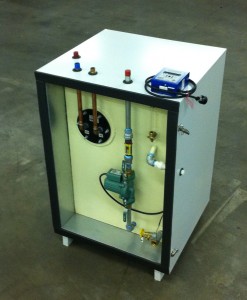Dr. Ben’s Solar Storage Tank

80 Gallon Solar Storage Tank
The solar storage tank is an essential component of almost every solar hot water system. The marketplace for residential solar tanks is overflowing with options for homeowners to consider. Big names like Rheem, A.O. Smith, and Lochinvar are spending millions of dollars each year to get a piece of the action.
The engineering mindset that made these companies the dominant players in hot water might work OK for residential solar storage… but it won’t fly for larger commercial applications.
Big solar thermal jobs are a different breed. They require a much more comprehensive strategy. Architects, engineers, or rookie solar contractors who think they can approach big jobs the same way Rheem, A.O. Smith, and Lochinvar approach their residential products are destined to create sub-par commercial systems.
I realized this back in the late 1970’s when I first got into the solar thermal game. Coming from a background in physics, I guess my thought process was a little bit different from the typical engineer. My strategy has always been based on how to most efficiently capture, retain, and deliver energy… call me crazy.
Regular followers of my blog will know that this philosophy led me to develop my own version of the “drainback” system design. If you haven’t read any of the articles regarding drainback, I suggest you start by clicking HERE for a primer. My design was utilized in hundreds of large-scale commercial solar thermal systems throughout the 80’s and 90’s, many of which are still operating thirty years later.
At the heart of this simple, yet rugged design is the solar storage tank.
It’s really not just a tank, though. It’s a complete solar hot water storage system that includes a non-pressurized steel tank, two inches of isocyanurate insulation, galvanized sheet metal jacketing, embedded heat exchangers, pumps, piping, and controls. That’s why I call it a “Fluid Handling System™” or FHS.
What’s the advantage?
Solar contractors know that optimizing time on the job site can make the difference between staying profitable and losing your shirt. No place is there more opportunity to get this wrong than in the mechanical room. Here, the installer has several critical tasks to accomplish…
- set the storage tank(s)
- set the heat exchanger(s)
- pipe the heat exchanger(s) to the tank(s)
- install the pump(s) and piping
- mount the controls
- wire the controls
- program the controller(s)
- insulate the tank
- insulate the pipes
Suppose you didn’t have to do ANY of that?
That’s the FHS advantage! It’s literally plug-and-play. Solar installers using the FHS instead of onsite assembly have reported a savings of 50% on their time and cost spent in the mechanical room. That’s money in their pocket with time left over to sell more jobs, not sweat more pipe.
Not only is the FHS a big cost saver, but it is more efficient than a site built system. All the components are selected for compatibility and factory installed with the highest quality control. This level of integration simply can’t be done on the site.
If you’re a solar contractor looking for ways to increase the profitability of your solar thermal installations, stop wasting your time with the typical solar storage tank solution. Cut your costs in half with a complete Fluid Handling System!
For a quote, click HERE.
For information on our residential models, click HERE.
Bye for now,
Dr. Ben
